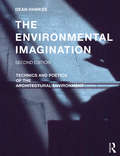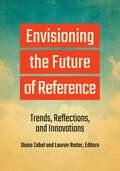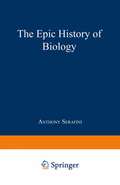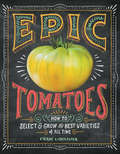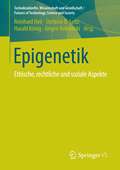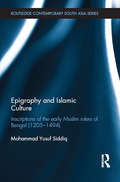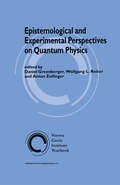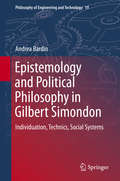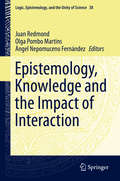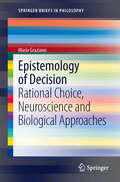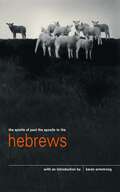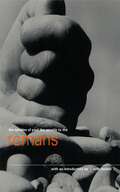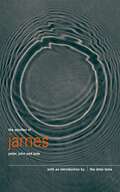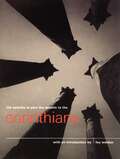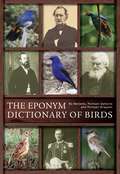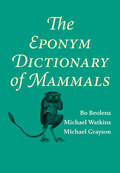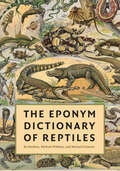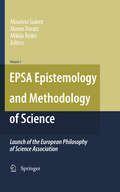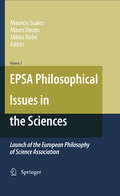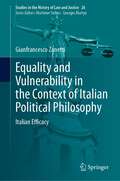- Table View
- List View
The Environmental Imagination: Technics and Poetics of the Architectural Environment
by Dean HawkesThe Environmental Imagination explores the relationship between tectonics and poetics in environmental design in architecture. Working thematically and chronologically from the eighteenth century to the present day, this book redefines the historiography of environmental design by looking beyond conventional histories to argue that the environments within buildings are a collaboration between poetic intentions and technical means. In a sequence of essays, the book traces a line through works by leading architects of the nineteenth and twentieth centuries that illustrate the impact of new technologies on the conception and realisation of environments in buildings. In this, a consideration of the qualitative dimension of environment is added to the primarily technological narratives of other accounts. In this second edition, the book has been substantially rewritten and restructured to include further research conducted in the decade since the first edition. A number of important buildings have been revisited, in order to extend the descriptions of their environments, and studies have been made of a number of newly studied, significant buildings. A completely new essay offers an environmental interpretation of Luis Barragán’s magical own house in Mexico City and the earlier studies of buildings by Peter Zumthor have been gathered into a single, extended essay that includes a body of new research. On the fiftieth anniversary of the publication of Reyner Banham’s, The Architecture of the Well-tempered Environment, the book concludes with a critical tribute to that seminal text. The Environmental Imagination will appeal to academics and practitioners with interests in the history, theory and technology of architecture.
The Environmental Imagination: Technics and Poetics of the Architectural Environment
by Dean HawkesThe Environmental Imagination explores the relationship between tectonics and poetics in environmental design in architecture. Working thematically and chronologically from the eighteenth century to the present day, this book redefines the historiography of environmental design by looking beyond conventional histories to argue that the environments within buildings are a collaboration between poetic intentions and technical means. In a sequence of essays, the book traces a line through works by leading architects of the nineteenth and twentieth centuries that illustrate the impact of new technologies on the conception and realisation of environments in buildings. In this, a consideration of the qualitative dimension of environment is added to the primarily technological narratives of other accounts. In this second edition, the book has been substantially rewritten and restructured to include further research conducted in the decade since the first edition. A number of important buildings have been revisited, in order to extend the descriptions of their environments, and studies have been made of a number of newly studied, significant buildings. A completely new essay offers an environmental interpretation of Luis Barragán’s magical own house in Mexico City and the earlier studies of buildings by Peter Zumthor have been gathered into a single, extended essay that includes a body of new research. On the fiftieth anniversary of the publication of Reyner Banham’s, The Architecture of the Well-tempered Environment, the book concludes with a critical tribute to that seminal text. The Environmental Imagination will appeal to academics and practitioners with interests in the history, theory and technology of architecture.
Envisioning the Future of Reference: Trends, Reflections, and Innovations
by Diane Zabel Lauren ReiterOffering a broad overview of consequential changes in the landscape of reference services, this guide also provides practical guidance on how to meet the new challenges they present.For the past decade, librarians have been lamenting the demise of reference services. Encouraging recent research shows that reference librarians are actually in more demand than ever; however, nearly everything about reference has changed—from technologies, tools, and techniques to models of service.What are these changes, and how can the profession respond to and prepare for shifting priorities and user needs? In this volume, business librarians Diane Zabel and Lauren Reiter bring together a host of experts to answer these timely questions. Topics range from the education and training of professionals to meeting the needs and wants of employers. Covered are trends in chat reference, research consultations, do-it-yourself reference, tracking trends with user populations, assessment, and data-driven decisions about reference services.Grounded in the principle that, regardless of the evolutions in service, the user remains at the center of reference, this guide offers readers an exciting look at the future of this important public service.
Envisioning the Future of Reference: Trends, Reflections, and Innovations
Offering a broad overview of consequential changes in the landscape of reference services, this guide also provides practical guidance on how to meet the new challenges they present.For the past decade, librarians have been lamenting the demise of reference services. Encouraging recent research shows that reference librarians are actually in more demand than ever; however, nearly everything about reference has changed—from technologies, tools, and techniques to models of service.What are these changes, and how can the profession respond to and prepare for shifting priorities and user needs? In this volume, business librarians Diane Zabel and Lauren Reiter bring together a host of experts to answer these timely questions. Topics range from the education and training of professionals to meeting the needs and wants of employers. Covered are trends in chat reference, research consultations, do-it-yourself reference, tracking trends with user populations, assessment, and data-driven decisions about reference services.Grounded in the principle that, regardless of the evolutions in service, the user remains at the center of reference, this guide offers readers an exciting look at the future of this important public service.
The Epic History of Biology
by Anthony SerafiniThe search for our elusive human origins and an understanding of the mysteries of the human body have challenged the most inquisitive and imaginative thinkers from Egyptian times through the twentieth century. In The Epic History of Biology, Anthony Serafini - a distinguished philosopher and historian of science - regales the reader with the triumphs and failures of the geniuses of the life sciences. The subtleties of the animal kingdom - anatomy, zoology, and reproduction - along with the complexities of the plant kingdom, have fascinated humanity as far back as 5000 years ago. Astounding ancient knowledge of the arcane curing powers of herbs as well as early experimentation with different chemical combinations for such purposes as mummification led to today's biological technology. Innovative pioneers such as Aristotle, Galen, Hippocrates, and Vesalius challenged the limits of knowledge and single-mindedly pursued their work, often in the face of blind superstition. In superb, lyrical prose Serafini recreates the ideas and theories of these revolutionaries from ancient times through today, against the backdrop of the dogma and prejudices of their time. He explores the inspired revelations that gave birth to such discoveries as the controversial theory of evolution, the humble origins of genetics, the fantastic predictions of quantum mechanics, and the infinite promise of computer technology. Even today the biological sciences are undergoing rapid and kaleidoscopic changes. Every new insight gives rise to a myriad of new ethical questions and responsibilities. The Epic History of Biology confronts these issues head on and predicts the wondrous new directions biology will follow.
Epic Tomatoes: How to Select and Grow the Best Varieties of All Time
by Craig LeHoullierSavor your best tomato harvest ever! Craig LeHoullier provides everything a tomato enthusiast needs to know about growing more than 200 varieties of tomatoes, from planting to cultivating and collecting seeds at the end of the season. He also offers a comprehensive guide to various pests and tomato diseases, explaining how best to avoid them. With beautiful photographs and intriguing tomato profiles throughout, Epic Tomatoes celebrates one of the most versatile and delicious crops in your garden.
Epigenetik: Ethische, rechtliche und soziale Aspekte (Technikzukünfte, Wissenschaft und Gesellschaft / Futures of Technology, Science and Society)
by Reinhard Heil Stefanie B. Seitz Harald König Jürgen RobienskiInnerhalb der letzten zehn Jahre hat sich die Epigenetik als ein Zweig der Molekulargenetik herausgebildet und erlebt einen regelrechten Hype. Die moderne Epigenetik vereint Wissenschaftlerinnen und Wissenschaftler aus den Lebenswissenschaften, der organischen Chemie, der Informatik und den Ingenieurwissenschaften bei der Beantwortung der Frage, wie Umwelteinflüsse die Genexpression langfristig und bis in die folgenden Generationen beeinflussen können. Der Band untersucht die wenig beachteten ethischen, rechtlichen und sozialen Aspekte der Epigenetik aus interdisziplinärer Perspektive.
Epigraphy and Islamic Culture: Inscriptions of the Early Muslim Rulers of Bengal (1205-1494) (Routledge Contemporary South Asia Series)
by Mohammad Yusuf SiddiqArchitectural inscriptions are a fascinating aspect of Islamic cultural heritage because of their rich and diverse historical contents and artistic merits. These inscriptions help us understand the advent of Islam and its gradual diffusion in Bengal, which eventually resulted in a Muslim majority region, making the Bengali Muslims the second largest linguistic group in the Islamic world. This book is an interpretive study of the Arabic and Persian epigraphic texts of Bengal in the wider context of a rich epigraphic tradition in the Islamic world. While focusing on previously untapped sources, it takes a fresh look into the Islamic inscriptions of Bengal and examines the inner dynamics of the social, intellectual and religious transformations of this eastern region of South Asia. It explores many new inscriptions including Persian epigraphs that appeared immediately after the Muslim conquest of Bengal indicating an early introduction of Persian language in the region through a cultural interaction with Khurasan and Central Asia. In addition to deciphering and editing the epigraphic texts, the information derived from them has been analyzed to construct the political, administrative, social, religious and cultural scenario of the period. The first survey of the Muslim inscriptions in India ever to be attempted on this scale, the book reveals the significance of epigraphy as a source for Islamic history and culture. As such, it will be of interest to students and scholars of Asian Studies, Asian History and Islamic Studies.
Epigraphy and Islamic Culture: Inscriptions of the Early Muslim Rulers of Bengal (1205-1494) (Routledge Contemporary South Asia Series)
by Mohammad Yusuf SiddiqArchitectural inscriptions are a fascinating aspect of Islamic cultural heritage because of their rich and diverse historical contents and artistic merits. These inscriptions help us understand the advent of Islam and its gradual diffusion in Bengal, which eventually resulted in a Muslim majority region, making the Bengali Muslims the second largest linguistic group in the Islamic world. This book is an interpretive study of the Arabic and Persian epigraphic texts of Bengal in the wider context of a rich epigraphic tradition in the Islamic world. While focusing on previously untapped sources, it takes a fresh look into the Islamic inscriptions of Bengal and examines the inner dynamics of the social, intellectual and religious transformations of this eastern region of South Asia. It explores many new inscriptions including Persian epigraphs that appeared immediately after the Muslim conquest of Bengal indicating an early introduction of Persian language in the region through a cultural interaction with Khurasan and Central Asia. In addition to deciphering and editing the epigraphic texts, the information derived from them has been analyzed to construct the political, administrative, social, religious and cultural scenario of the period. The first survey of the Muslim inscriptions in India ever to be attempted on this scale, the book reveals the significance of epigraphy as a source for Islamic history and culture. As such, it will be of interest to students and scholars of Asian Studies, Asian History and Islamic Studies.
Epistemological and Experimental Perspectives on Quantum Physics (Vienna Circle Institute Yearbook #7)
by Daniel Greenberger W. L. Reiter Anton ZeilingerFrom the very beginning it was realised that quantum physics involves radically new interpretative and epistemological consequences. While hitherto there has been no satisfactory philosophical analysis of these consequences, recent years have witnessed the accomplishment of many experiments to test the foundations of quantum physics, opening up vistas to a completely novel technology: quantum technology. The contributions in the present volume review the interpretative situation, analyze recent fundamental experiments, and discuss the implications of possible future technological applications. Readership: Analytic philosophers (logical empiricists), scientists (especially physicists), historians of logic, mathematics and physics, philosophers of science, and advanced students and researchers in these fields. Can be used for seminars on theoretical and experimental physics and philosophy of science, and as supplementary reading at advanced undergraduate and graduate levels.
Epistemology and Political Philosophy in Gilbert Simondon: Individuation, Technics, Social Systems (Philosophy of Engineering and Technology #19)
by Andrea BardinThis combination of historiography and theory offers the growing Anglophone readership interested in the ideas of Gilbert Simondon a thorough and unprecedented survey of the French philosopher’s entire oeuvre. The publication, which breaks new ground in its thoroughness and breadth of analysis, systematically traces the interconnections between Simondon’s philosophy of science and technology on the one hand, and his political philosophy on the other.The author sets Simondon’s ideas in the context of the epistemology of the late 1950s and the 1960s in France, the milieu that shaped a generation of key French thinkers such as Deleuze, Foucault and Derrida. This volume explores Simondon’s sources, which were as eclectic as they were influential: from the philosophy of Bergson to the cybernetics of Wiener, from the phenomenology of Merleau-Ponty to the epistemology of Canguilhem, and from Bachelard’s philosophy of science to the positivist sociology and anthropology of luminaries such as Durkheim and Leroi-Gourhan. It also tackles aspects of Simondon’s philosophy that relate to Heidegger and Elull in their concern with the ontological relationship between technology and society and discusses key scholars of Simondon such as Barthélémy, Combes, Stiegler, and Virno, as well as the work of contemporary protagonists in the philosophical debate on the relevance of technique. The author’s intimate knowledge of Simondon’s language allows him to resolve many of the semantic errors and misinterpretations that have plagued reactions to Simondon’s many philosophical neologisms, often drawn from his scientific studies.
Epistemology, Knowledge and the Impact of Interaction (Logic, Epistemology, and the Unity of Science #38)
by Juan Redmond Olga Pombo Martins Ángel Nepomuceno FernándezWith this volume of the series Logic, Epistemology, and the Unity of Science edited by S. Rahman et al. a challenging dialogue is being continued. The series’ first volume argued that one way to recover the connections between logic, philosophy of sciences, and sciences is to acknowledge the host of alternative logics which are currently being developed. The present volume focuses on four key themes. First of all, several chapters unpack the connection between knowledge and epistemology with particular focus on the notion of knowledge as resulting from interaction. Secondly, new epistemological perspectives on linguistics, the foundations of mathematics and logic, physics, biology and law are a subject of analysis. Thirdly, several chapters are dedicated to a discussion of Constructive Type Theory and more generally of the proof-theoretical notion of meaning.Finally, the book brings together studies on the epistemic role of abduction and argumentation theory, both linked to non-monotonic approaches to the dynamics of knowledge.
Epistemology of Decision: Rational Choice, Neuroscience and Biological Approaches (SpringerBriefs in Philosophy)
by Mario GrazianoThis book carries out an epistemological analysis of the decision, including a critical analysis through the continuous reference to an interdisciplinary approach including a synthesis of philosophical approaches, biology and neuroscience. Besides this it represents the analysis of causality here seen not from the formal point of view, but from the "embodied" point of view.
The Epistle of Paul the Apostle to The Hebrews (The Pocket Canons #21)
by Karen ArmstrongHebrews marks a parting of the ways for Jews and Christians of the first century. It makes a case for the superiority of the new Christian 'faith' over old Hebrew orthodoxy and draws on the Old Testament for precedents for Jesus's ministry and to paint a picture of Jesus.
The Epistle of Paul the Apostle to The Romans (The Pocket Canons #20)
by Ruth RendellPaul was the most influential figure in the early Christian church. In this epistle, written to the founders of the church in Rome, he sets out some of his ideas on the importance of faith in overcoming mankind's innate sinfulness and in obtaining redemption. With an introduction by Ruth Rendell
The Epistles of James, Peter, John and Jude (The Pocket Canons #22)
by Dalai LamaAlongside the epistles of Paul in the New Testament are short letters of four unknown early Christian writers, James, Peter, John and Jude. Those of Peter were composed in excellent Greek, James emphasizes the need for good works and Peter berates false prophets. With an introduction by the Dalai Lama.
The Epistles of Paul the Apostle to The Corinthians (The Pocket Canons #11)
by Fay WeldonA figurehead of the early Christian church, Paul sets out some of his thoughts on strife and division, spirituality, the bond of marriage and hopes for his own immortality in this book. With an introduction by Fay Weldon
The Eponym Dictionary of Birds
by Bo Beolens Michael Watkins Michael GraysonBirdwatchers often come across bird names that include a person's name, either in the vernacular (English) name or latinised in the scientific nomenclature. Such names are properly called eponyms, and few people will not have been curious as to who some of these people were (or are).Names such as Darwin, Wallace, Audubon, Gould and (Gilbert) White are well known to most people. Keener birders will have yearned to see Pallas's Warbler, Hume's Owl, Swainson's Thrush, Steller's Eider or Brünnich's Guillemot. But few people today will have even heard of Albertina's Myna, Barraband's Parrot, Guerin's Helmetcrest or Savigny's Eagle Owl. This extraordinary new work lists more than 4,000 eponymous names covering 10,000 genera, species and subspecies of birds. Every taxon with an eponymous vernacular or scientific name (whether in current usage or not) is listed, followed by a concise biography of the person concerned. These entries vary in length from a few lines to several paragraphs, depending on the availability of information or the importance of the individual's legacy. The text is punctuated with intriguing or little-known facts, unearthed in the course of the authors' extensive research.Ornithologists will find this an invaluable reference, especially to sort out birds named after people with identical surnames or in situations where only a person's forenames are used. But all birders will find much of interest in this fascinating dictionary, an ebook to dip into time and time again whenever their curiosity is aroused.
The Eponym Dictionary of Birds
by Bo Beolens Michael Watkins Michael GraysonBirdwatchers often come across bird names that include a person's name, either in the vernacular (English) name or latinised in the scientific nomenclature. Such names are properly called eponyms, and few people will not have been curious as to who some of these people were (or are).Names such as Darwin, Wallace, Audubon, Gould and (Gilbert) White are well known to most people. Keener birders will have yearned to see Pallas's Warbler, Hume's Owl, Swainson's Thrush, Steller's Eider or Brünnich's Guillemot. But few people today will have even heard of Albertina's Myna, Barraband's Parrot, Guerin's Helmetcrest or Savigny's Eagle Owl. This extraordinary new work lists more than 4,000 eponymous names covering 10,000 genera, species and subspecies of birds. Every taxon with an eponymous vernacular or scientific name (whether in current usage or not) is listed, followed by a concise biography of the person concerned. These entries vary in length from a few lines to several paragraphs, depending on the availability of information or the importance of the individual's legacy. The text is punctuated with intriguing or little-known facts, unearthed in the course of the authors' extensive research.Ornithologists will find this an invaluable reference, especially to sort out birds named after people with identical surnames or in situations where only a person's forenames are used. But all birders will find much of interest in this fascinating volume, a book to dip into time and time again whenever their curiosity is aroused.
The Eponym Dictionary of Mammals
by Michael Watkins Bo Beolens Michael GraysonJust who was the Przewalski after whom Przewalski's horse was named? Or Husson, the eponym for the rat Hydromys hussoni? Or the Geoffroy whose name is forever linked to Geoffroy's cat? This unique reference provides a brief look at the real lives behind the scientific and vernacular mammal names one encounters in field guides, textbooks, journal articles, and other scholarly works.Arranged to mirror standard dictionaries, the more than 1,300 entries included here explain the origins of over 2,000 mammal species names. Each bio-sketch lists the scientific and common-language names of all species named after the person, outlines the individual's major contributions to mammalogy and other branches of zoology, and includes brief information about his or her mammalian namesake's distribution. The two appendixes list scientific and common names for ease of reference, and, where appropriate, individual entries include mammals commonly—but mistakenly—believed to be named after people.The Eponym Dictionary of Mammals is a highly readable and informative guide to the people whose names are immortalized in mammal nomenclature.
The Eponym Dictionary of Reptiles
by Bo Beolens Michael Watkins Michael GraysonWho was Richard Kemp, after whom the Kemp’s ridley sea turtle is named? Is Wake’s Gecko named after Berkeley’s Marvalee Wake? Or perhaps her husband, David? Why do so many snakes and lizards have Werner in their name? This reference book answers these and thousands of other questions about the origins of the vernacular and scientific names of reptiles across the globe.From Agkistrodon piscivorus conanti, the Florida cottonmouth subspecies named for Roger Conant, to Xantusia, the night lizard genera namesake of John Xantus, this dictionary covers everyone after whom an extant or recently extinct reptile has been named. The entries include a brief bio-sketch, a list of the reptiles that bear the individual’s name, the names of reptiles erroneously thought to be associated with the person, and a summary of major—and sometimes obscure or even incidental—contributions made by the person to herpetology and zoology. An introductory chapter explains how to use the book and describes the process of naming taxa. Easy to use and filled with addictive—and highly useful—information about the people whose names will be carried into the future on the backs of the world’s reptiles, The Eponym Dictionary of Reptiles is a handy and fun book for professional and amateur herpetologists alike.
The Eponym Dictionary of Reptiles
by Michael Watkins Bo Beolens Michael GraysonWho was Richard Kemp, after whom the Kemp’s ridley sea turtle is named? Is Wake’s Gecko named after Berkeley’s Marvalee Wake? Or perhaps her husband, David? Why do so many snakes and lizards have Werner in their name? This reference book answers these and thousands of other questions about the origins of the vernacular and scientific names of reptiles across the globe.From Agkistrodon piscivorus conanti, the Florida cottonmouth subspecies named for Roger Conant, to Xantusia, the night lizard genera namesake of John Xantus, this dictionary covers everyone after whom an extant or recently extinct reptile has been named. The entries include a brief bio-sketch, a list of the reptiles that bear the individual’s name, the names of reptiles erroneously thought to be associated with the person, and a summary of major—and sometimes obscure or even incidental—contributions made by the person to herpetology and zoology. An introductory chapter explains how to use the book and describes the process of naming taxa. Easy to use and filled with addictive—and highly useful—information about the people whose names will be carried into the future on the backs of the world’s reptiles, The Eponym Dictionary of Reptiles is a handy and fun book for professional and amateur herpetologists alike.
EPSA Epistemology and Methodology of Science: Launch of the European Philosophy of Science Association
by Mauricio Suárez Miklós Rédei Mauro DoratoThese two volumes containa selection of the papers delivered at the rst conference of the European Philosophy of Science Association (EPSA) which took place in Madrid,at Complutense University,from 14 to 17 November 2007.
EPSA Philosophical Issues in the Sciences: Launch of the European Philosophy of Science Association
by Mauricio Suárez Mauro Dorato Miklós RédeiThis volume collects papers presented at the Founding Conference of the European Philosophy of Science Association meeting, held November 2007. It provides an excellent overview of the state of the art in philosophy of science in different European countries.
Equality and Vulnerability in the Context of Italian Political Philosophy: Italian Efficacy (Studies in the History of Law and Justice #26)
by Gianfrancesco ZanettiOne of the main goals of this book is to determine if, in the works of some of the key authors in the history of Italian political philosophy, a notion of “efficacy” can be found. In legal philosophy, “efficacy” is the capacity a norm has to effectively influence citizens’ behavior. The “principle of efficacy” is that according to which an order or rule exists as such when it is followed effectively in practice. Here by “efficacy” I mean the idea that normative phenomena are self-justifying, without reference to extrinsic systems of value (such as “natural law”). The examinations of several texts undertaken here constitute reflections on this theme, without any claim to systematicity. They have been grouped together, roughly in historical order, by their common respect for the contexts within which they reason and reach decisions, which lends them a characteristic flavor of harsh realism that at times relies on a minimalist use of traditional normative categories.The second theme that emerges through the respective chapters (each of which constitutes the text for a lesson in a course for Ph.D. students) is that of the relationship between “equality” and “vulnerability.” Here the idea is to elaborate a concept of “vulnerability” that is not underpinned by what we in Italy call an “anthropology,” that is, a fixed notion of human nature. Instead this concept should be comprehensible and graspable solely on the basis of the recognition of decisions and actions that are merely “efficacious,” that function “for what they are, and what they do.” This recognition doesn’t even need to be explicitly articulated by these authors with any specific, deliberately conscious awareness.The goal is not to identify a precise tradition of thought, one which elaborates a given line of reflection, but rather to highlight certain “themes” that emerge in the texts examined, even as the authors write with and for their own specific, contingent set of motives, which differ from time to time and place to place. These authors include some who are widely known, such as Dante, Machiavelli, and Beccaria. At times they are figures who typify certain key historical episodes, such as the Risorgimento (Giuseppe Mazzini) or Fascism (Cesare Lombroso and Santi Romano), while others reflect certain aspects of a contemporary debate (Pasolini and the “Braibanti affair”).The book is based on lectures given for a 2021 Ph.D. Course at the University of California, Berkeley’s Department of Italian Studies.
